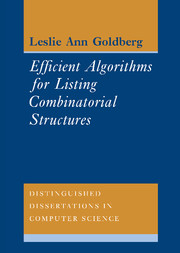Book contents
3 - Applications to Particular Families of Structures
Published online by Cambridge University Press: 14 January 2010
Summary
Chapter 2 described several general methods for listing combinatorial structures. In order to illustrate the methods we applied them to a few specific families of structures. In addition, we made some observations concerning the application of the methods to various classes of combinatorial families including graph properties and recursively listable families.
While the examples in chapter 2 involved particular combinatorial families, the focus of our attention was on the general listing methods. In this chapter we will shift the focus of our attention to applications. We will be interested in looking at the particular algorithms that we have developed in the course of this work and in finding out what we have learned about particular combinatorial families in the course of the work.
We start by considering a few results from chapter 2 which we will not pursue farther in this chapter. First, consider Uniform Reducer 2 which we described in subsection 2.1.2. In theorem 2 we proved that whenever Uniform Reducer 2 is combined with any efficient random sampling algorithm S-Sample for any simple family S it becomes a probabilistic polynomial delay listing algorithm for S. The listing algorithm has exponentially small failure probability. This theorem leads immediately to efficient probabilistic listing algorithms for a number of interesting families of structures since other people have developed random sampling algorithms for these families.
For example, let Sp be the family with the following definition.
- Type
- Chapter
- Information
- Efficient Algorithms for Listing Combinatorial Structures , pp. 84 - 118Publisher: Cambridge University PressPrint publication year: 1993



